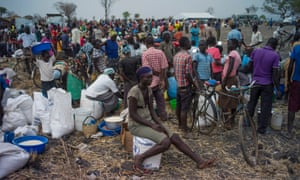Thinking Big, Finding Solutions, Living With the Sea
"For us, climate change is beyond ideology."
"Rotterdam lies in the most vulnerable part of the Netherlands, both economically and geographically."
"If the water comes in, from the rivers or the sea, we can evacuate maybe 15 out of 100 people. So evacuation isn't an option. We can escape only into high buildings."
"We have no choice, We must learn to live with water. That's just common sense."
Ahmed Aboutaleb, mayor, Rotterdam, Netherlands
"A smart city has to have a comprehensive, holistic vision beyond levees and gates."
"The challenge of climate adaptation is to include safety, sewers, housing, roads, emergency services. You need public awareness. You also need cyber resilience, because the next challenge in climate safety is cybersafety."
"You can't have vulnerable systems that control your sea gates and bridges and sewers. And you need good policies, big and small."
"This starts with little things, like getting people to remove the concrete pavement from their gardens so the soil underneath absorbs rainwater. It ends with the giant storm surge barrier at the North Sea."
Arnoud Molenaar, climate chief, Rotterdam, Netherlands
 |
The biggest mobile barrier in the world, the Maeslant storm surge
barrier was built to protect the Dutch city of Rotterdam from a
one-in-10,000-year storm. It's part of the massive investment the Dutch
are making to protect themselves in a new era of rising sea levels. Credit: Bert Knottenbeld/Flickr Creative Commons
|
About a half-hour drive from downtown Rotterdam near the mouth of the sea, is the Maeslantkering, an unbelievably immense set of gates, established there to hold back potential floods. The repeated North Sea floods that historically overwhelmed the coastline of Holland convinced its politicians and city planners that they needed to be proactive in defending and protecting their cities against storms that had catastrophic consequences. Two major waterways were dammed to produce the Maeslantkering which was put in place twenty years ago.
 |
| The giant Maeslant surge barrier guards the entrance to the Port of Rotterdam. Photograph: Kina Rob Doolaard/AFP/Getty Images |
This giant sea gate was built to maintain the immense waterway that enables the port of Rotterdam to remain a commercial shipping port servicing Europe as the world's busiest port. Tens of thousands of ships from across the globe sail into Rotterdam, in the process supplying steel to Germany, petrochemicals to South America and everything else imaginable to anywhere else in the world. The city of over 600,000 souls is dependent on the port for its very existence, accounting for no fewer than 90,000 jobs.
The structure represents a monumental gate with two arms, each resting on either side of the canal, a unimaginably complex formula of advanced technical engineering, yet one of great beauty, an impressive marvel of ingenuity to solve a once-intractable problem that saw 1,800 people die in 1953 when an overnight storm wreaked havoc on the Dutch coastline. When the gate is in its closed state, the arms float out onto the canal; they meet and lock, tubes filling with water, sinking onto a concrete platform resulting in an impenetrable steel wall challenging the North Sea.
 |
Floating buildings like this pavilion in Rotterdam's old harbor
are still a boutique solution even in the Netherlands, but Hans
Baggerman says they could become more common as climate change forces
developers to get creative. "A lot of parts of Holland are outside of
the dikes," Baggerman says. "There’s no way you can build buildings
unless they are floating." Credit: Joris van Gennip/The GroundTruth
|
It takes fully two-and-a-half hours for the process to close the gates to be completed. Sea pressure becomes transferred from the wall to the largest ball joints in the world, installed in the banks on either side of the river. A closed computerized electronic system is used to sidestep the possibility of cyberattacks, to hourly monitor sea levels, as well as operating to close the gate automatically, or to open it. Within the gate, thirty pumps are linked to a power grid, extracting water from the tubes at such time when the Maeslantkering is to be reopened. A backup grid exists if the first one fails, and a generator is also available to open the gate if required.
"It's an example of what you can do if you connect storm-water management with social welfare and neighbourhood improvements", explains Paul van Roosmalen of a dike close to the industrial waterfront where a largely immigrant and poor neighbourhood takes advantage of a shopping center built upon the dike, along with a grassy park on its roof which slopes down to the streets, and housing blocks; a place where sunbathers enjoy the grassy roof and Frisbees are tossed for fun and games. The kilometer-long park has formal gardens as well. "It's what we mean here in Rotterdam by 'resilience planning'."
"It's in our genes", said Rotterdam's climate chief. "We have been able to put climate change adaptation high on the public agenda without suffering a disaster in many years because we have shown the benefits of improving public space -- the added economic value of investing in resilience. Water managers were the first rulers of the land. Designing the city to deal with water was the first task of survival here and it remains our defining job. It's a process, a movement. It is not just a bunch of dikes and dams, but a way of life", stated Mr. Molenaar.
 |
| Rotterdam in the Netherlands has the largest port in Europe. Photograph: Frans Lemmens/Corbis |
Labels: Climate Change, Netherlands, Technology








